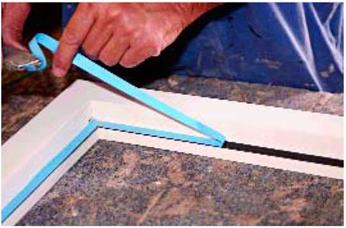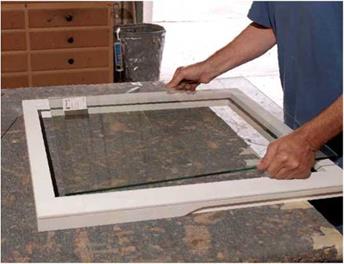REPLACING GLASS
Wear goggles and gloves when replacing damaged glass and dried-out putty (glazing compound). Although a glazier’s chisel will easily remove most putty, use paint stripper or an electric putty softener to dislodge the tough stuff. (But do not use chemical stripper and heat at the same time.) Because direct heat can crack glass, cover nearby panes with a piece of hardboard wrapped in protective foil. After removing the old putty, glazier’s points, and damaged glass, sand the frame lightly, using 180-grit sandpaper.
Prepping the frame. Before applying new glazing compound to weathered sashes, brush the exposed wood with a sealant or a half-and-half mixture of alcohol (or turpentine) and linseed oil. This will prevent the dry wood from sucking the oil out of the fresh putty. Let the sash dry for an hour or two. Then spread a thin bed of putty along the lip that receives the glass. This bed of putty will prevent rattling and seal air leaks. The replacement pane should be in. smaller than the width and length of the frame.
Cutting the glass. After scribing the glass with a glass cutter, gently rap the ball end of the cutter along the underside of the cut—up and down its length—until a clear line develops. Then, with the cut directly over a table edge, quickly snap the waste portion free. If the waste piece is too small to grip, use glass pliers. Note: Old glass is imperfect and often hard to cut because it’s irregular and often doesn’t break cleanly.
As you place the glass in the frame, press around the edges so that the putty will seat evenly beneath the pane. With a putty knife held almost flat against the glass, push in new glazier’s points until they are half-buried. (Never hammer the points in; you may break the glass.) Sink a point every 6 in., or at least one for each side of the glass. Be particularly careful when pushing points into muntins (the wooden strips between panes); if you push a point in too far, you could crack the adjacent pane. Glass in metal-frame windows is usually held in place by metal spring clips, which can be reused.
Once the replacement pane is held fast by glazier’s points, apply putty generously. Scoop
out a palmful of putty and knead it in one hand until it is soft and pliable. Use your thumb to press the putty into the frame, applying moderate pressure. You’ll recover any excess when you trim, so use a lot of putty now to ensure getting a good seal.
To trim off the excess, hold the knife blade at an angle of about 45° to the glass, with a corner of the blade touching the glass and the middle of the blade resting on the frame. Pull the knife evenly toward you, plowing a steady furrow through the putty. Go back and touch up the corners after removing most of the excess. You


![]()

![]()
shouldn’t be able to see putty from the inside of the window once it has been trimmed.
If the putty doesn’t stick, either you’re holding the knife handle too high or there is dust on the frame or the glass. If the problem is just the drag of the knife blade across the putty, a bit of saliva on the blade will lubricate it. When the putty has cured for a week, overpaint it slightly onto the glass to seal the putty from weather.






Leave a reply